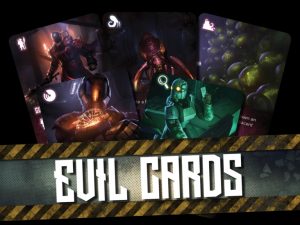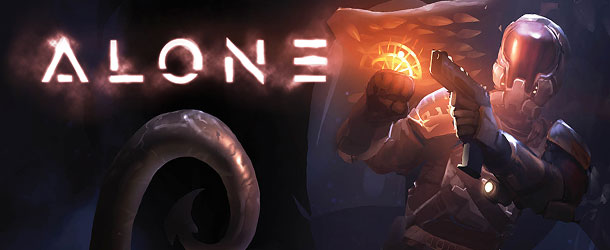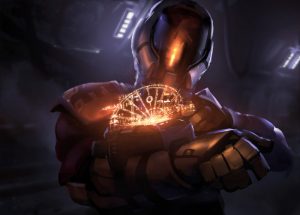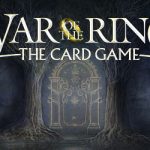Welcome back to Discovering Alone. In the previous articles, we introduced the game and described its background story. Now, let’s learn more about the game’s development, by (who can tell this story better) the game designers Andrea Crespi and Lorenzo Silva!.
Andrea Crespi (AC): The development of Alone has been long and difficult. We knew that when we started working on it of course, since it was our first venture with a big and complex game like a dungeon crawler… we just didn’t know how much. This was not our first experience as co-designers (the latest game we designed together, along with Stefano Castelli, is “Potion Explosion”), but we never tackled a game this complex before.
Lorenzo Silva (LS): Even though we co-developed Alone, the credit for the game’s concept of “one good guy against many evil guys” goes entirely to Andrea. As his previous work shows (other than "Potion Explosion", he designed "1969" and "Apollo XIII"), he is a huge space exploration geek. He used to have a big-scale replica of the Apollo lander in his basement, and he often wears an actual NASA jacket.
AC: The idea came to me while watching Ridley Scott’s “Alien”, the first movie in the now legendary science fiction / horror series. The chances you have never seen that movie are quite thin, but here’s a quick recap, just in case: Ellen Ripley’s adventure is a story about a “regular” woman who finds herself alone against a cruel universe, forced to face deadly dangers. The series became more and more action-oriented with its sequels, but the first movie has this peculiar and fascinating (even if slightly disturbing) feeling of haunting loneliness and constant danger that has few equivalents in the history of cinema. The Dead Space video game franchise was also a big influence, at least thematically. Being a huge board game geek, other than a space exploration and video game one, I quickly realized how cool it would be to make a game that gave you that feeling. A standard dungeon crawler turned upside down, with one single “hero” facing several “dungeon masters”.
LS: The early prototype he showed to me already had some of the features that are still present in the final game. As soon as we played the first game, a title came to my mind: Alone, and it stayed like that ever since (that rarely happens with our games, we tend to use many different working titles, before eventually settling down for the final one).
AC: But for the Hero we were using a Han Solo miniature from "Imperial Assault"! That’s because “Solo” in Italian means “Alone”.
LS: And because Star Wars is cool, of course!
AC: One of the earliest changes we made when Lorenzo stepped in as co-designer was the introduction of the player screen. Only the Evil players could see the whole map, the Hero could only see the Sectors immediately nearby. This was a huge improvement to both the feel and the gameplay, and it roughly remained unchanged since its first inception. Still, the game was far from done. The biggest issue, at that stage, was the downtime for the Hero during the Evil players turn. They had a lot of micromanagement to do, all creatures had to be moved, new traps would have to be set… and the Evil players had to discuss and decide together what to do! It was very frustrating for the Hero player.
LS: The problem was obvious, but the solution proved to be quite tricky to nail down. We decided at once that we needed to remove the Evil turn and make it “gradually happen” during the Hero’s turn. We wanted to create a constant back and forth between the two sides, but we had to try many different solutions to make it work. And even after that, it still took several attempts to fix all the new problems this change created to the existing game mechanics. When does the Hero’s turn end? Do we even still need a “Hero turn”, can’t we remove it too and just have a continuous flow of actions? What triggers the end of the missions? When do the resource pools of the players reset? And so on…
AC: Eventually, we decided that the passage of time would be determined by the number of actions the Hero can spend each round. The Evil players could only react to his actions. But even then, could they make more than one reaction in a row? Can the Hero counter-react to this? There were so many possibilities, each one bringing the game in a different direction. We wanted the game to be immersive, but also to keep it as streamlined, simple and elegant as possible. The risk (and the temptation) to go overdrive with an ameritrash-style flood of highly detailed rules and small exceptions was always there.
LS: Another aspect of the game we had to think a lot about was the division of roles between the Evil players. For the nature of the game, the Evil players just need to be all on the same side. We couldn’t add any sort of competition between them and have them win or lose together.
AC: When we did try to have competition among the Evil players, we’ve seen Evil players decide to let the Hero win, to prevent one of their fellow Evil players to win instead. “If I can’t win, then I’ll bring everybody down with me”. A really awful feeling. But the other side of the coin was: if they all play together, own the same resources, and have complete control of all the traps and creatures, how do we prevent “alpha players” to dominate the others, and effectively turn a “one vs. many” game into a two player game with spectators?
LS: This is why we introduced the Evil Leader mechanic. Only one Evil player is allowed to play without limits during each Hero’s turn, the others can only play a few things, and only if the Leader allows it. On top of that, each one of them has a differently themed card deck! Each Evil player is stronger than the others in one of the aspects of the game because of that (the Fury deck makes fighting the Hero more effective, the Fear deck allows to more efficiently weaken the Hero’s Self-Control, etc.)

Each Evil player has a differently themed card deck and is stronger than the others in one of the aspects of the game.
AC: Depending on which Evil player is the Leader each round, the Hero can really feel the difference… and he may even have to adjust his own gameplay strategies accordingly. It’s better to avoid a fight, when the Fury player is on charge! This also makes each Evil player feel unique.
LS: Yes, we didn’t want the Evil side of the game to be just one player split among different people, both because it’s a bad feeling, and because of the alpha player issues we mentioned before.
AC: When the thematic decks were introduced, and we made the last major overhaul of the card mechanic, we’ve finally been able to find the solution to another long-standing issue we had. What is the cost for the Evil players to perform their Reactions? The answer was… the card themselves! All non-card-related Reactions get paid by “sacrificing” (i.e. discarding) cards, and when playing cards, the very fact that a card is being removed from the hand to be played is a cost in and of itself.
LS: Also, because the Evil players cannot replenish their hand of cards until the Hero’s turn is over. If they play/discard too many cards early on, the Hero will be able to play the remainder of his turn undisturbed!
AC: Moreover, some cards have “requirements”, particular gameplay conditions needed to be played most effectively (like having a Creature in the Hero’s sector, etc.). This gives the Evil players many interesting choices. Should I play this card now, for little effect, save it for later and better use, or just discard it to do this other cool thing?”
LS: We could keep babbling about the many scenario structures we tried, and the various fighting mechanics, the iterations of the item “search and combine” mechanic, the evolving monsters… there are a lot of untold stories yet, but we’ve been boring people long enough!
AC: The core lesson we learned during the development of Alone is that, much more than in other kind of games, you can never really know what unpredictable side effects an apparently simple change in one of the many game mechanics can have, in totally unexpected areas of the game!
LS: That, and that dungeon crawlers are difficult!
This is all for today. The next Discovering Alone article will present the gameplay mechanics for both the Hero and the Evil players.
Previous articles: Game Overview, The World of Alone
Next articles: Hero Gameplay, Evil Gameplay, The Art of Alone
* "Discovering Alone" articles were originally published during the first game's Kickstarter project, by Horrible Guild's team.














